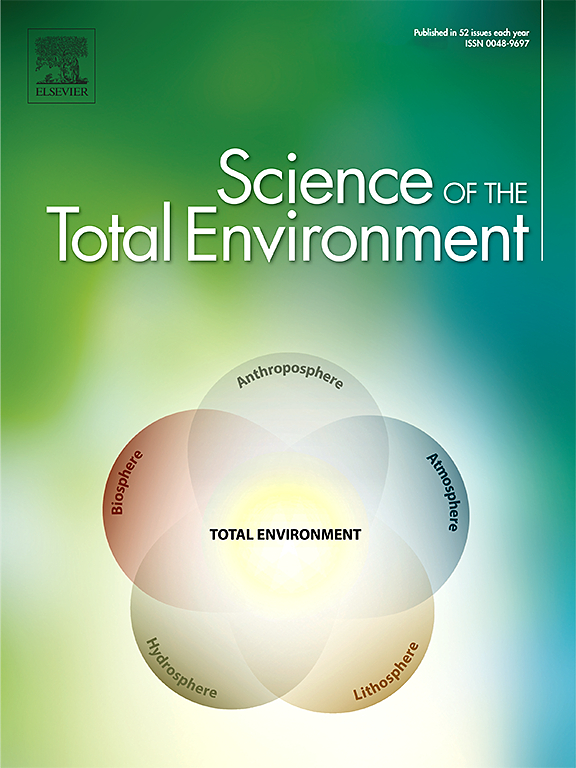Global teal carbon: Stocks, sequestration, and its potential role in climate change mitigation
IF 8
1区 环境科学与生态学
Q1 ENVIRONMENTAL SCIENCES
引用次数: 0
Abstract
A colour-based nomenclature has developed in recent decades to characterise the distribution and distinct functions of organic carbon in natural ecosystems. ‘Teal carbon’, which is found in shallow inland freshwater wetlands, is the newest type of carbon added to the colour spectrum. Teal carbon ecosystems are more susceptible to anthropogenic activities and climate change than green and blue carbon ecosystems. A detailed global review of major teal carbon ecosystems was performed to highlight the status of teal carbon and its potential role in mitigating global climate change. Our estimates indicate that peatlands, (non-tidal freshwater) swamps, and (non-tidal freshwater) marshes store (mean ± standard deviation) approximately 101.63 ± 68.12 (1016 ± 681), 42.82 ± 40.01 (428 ± 400), and 13.97 ± 10.77 (140 ± 108) kg C m−2 (Mg C ha−1), respectively. The study highlights teal carbon ecosystems as major natural carbon emitters, with methane emissions of 68.79 ± 237.58, 30.48 ± 53.17, and 104.37 ± 130.82 g C-CH4 m−2 yr−1, and carbon dioxide emissions of 644.59 ± 1018.56 and 713.07 ± 881.75 g C-CO2 m−2 yr−1, respectively. On the other hand, peatlands, swamps, and marshes store considerable atmospheric carbon at the rate (mean ± standard deviation) of 125.5 ± 16.5, 216.7 ± 255.8 and 180 ± 170.5, respectively. Due to its extensive global reach and high annual carbon sequestration rate, teal carbon ecosystems have the highest global carbon sequestration potential, surpassing blue and green carbon ecosystems if they are properly conserved and managed. Therefore, the Development of Self-sustaining Teal Carbon Zones (DSTCZ) can be a natural climate solution (NCS) providing numerous ecosystem services to society. Conservation, restoration, and improved global datasets are necessary to enhance the natural carbon storage efficacy of ecosystems and refine climate projections.

全球绿色碳:储量、固存及其在减缓气候变化中的潜在作用
近几十年来,一种基于颜色的命名法发展起来,以表征有机碳在自然生态系统中的分布和独特功能。“蓝绿色碳”存在于内陆浅水淡水湿地,是添加到光谱中的最新一种碳。绿色碳生态系统比绿色和蓝色碳生态系统更容易受到人为活动和气候变化的影响。对全球主要绿色碳生态系统进行了详细的回顾,以强调绿色碳的地位及其在减缓全球气候变化中的潜在作用。结果表明,泥炭地、(非潮汐淡水)沼泽和(非潮汐淡水)沼泽的碳储量(平均±标准差)分别约为101.63±68.12(1016±681)、42.82±40.01(428±400)和13.97±10.77(140±108)kg C m−2 (Mg C ha−1)。研究表明,蓝绿色碳生态系统是主要的自然碳排放源,甲烷排放量分别为68.79±237.58、30.48±53.17和104.37±130.82 g C-CH4 m−2 yr−1,二氧化碳排放量分别为644.59±1018.56和713.07±881.75 g C-CO2 m−2 yr−1。泥炭地、沼泽和沼泽分别以125.5±16.5、216.7±255.8和180±170.5的平均±标准差储存了大量的大气碳。由于其广泛的全球覆盖范围和较高的年固碳率,如果得到适当的保护和管理,绿色碳生态系统具有最高的全球固碳潜力,超过蓝色和绿色碳生态系统。因此,发展自给自足的绿色碳带(DSTCZ)可以成为一种自然气候解决方案(NCS),为社会提供多种生态系统服务。保护、恢复和改进全球数据集对于提高生态系统的自然碳储存效率和改进气候预测是必要的。
本文章由计算机程序翻译,如有差异,请以英文原文为准。
求助全文
约1分钟内获得全文
求助全文
来源期刊

Science of the Total Environment
环境科学-环境科学
CiteScore
17.60
自引率
10.20%
发文量
8726
审稿时长
2.4 months
期刊介绍:
The Science of the Total Environment is an international journal dedicated to scientific research on the environment and its interaction with humanity. It covers a wide range of disciplines and seeks to publish innovative, hypothesis-driven, and impactful research that explores the entire environment, including the atmosphere, lithosphere, hydrosphere, biosphere, and anthroposphere.
The journal's updated Aims & Scope emphasizes the importance of interdisciplinary environmental research with broad impact. Priority is given to studies that advance fundamental understanding and explore the interconnectedness of multiple environmental spheres. Field studies are preferred, while laboratory experiments must demonstrate significant methodological advancements or mechanistic insights with direct relevance to the environment.
 求助内容:
求助内容: 应助结果提醒方式:
应助结果提醒方式:


